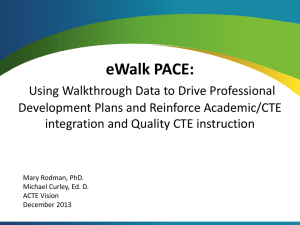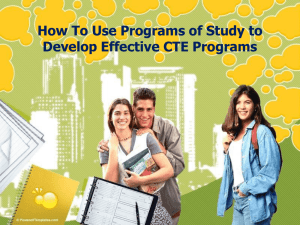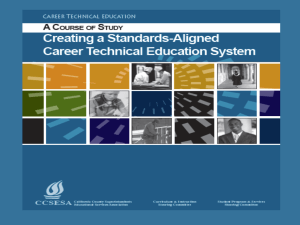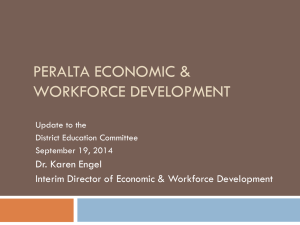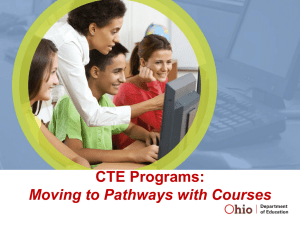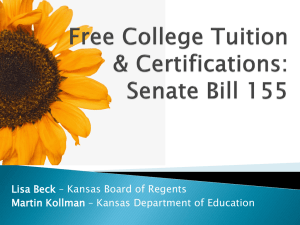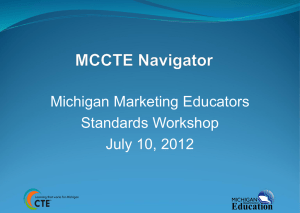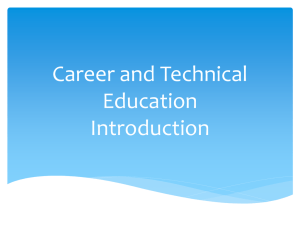Presentation Part 2
advertisement
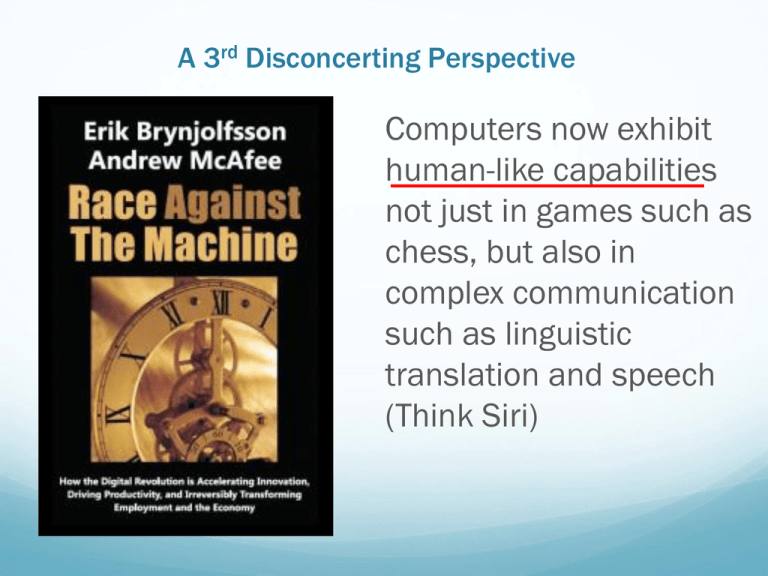
A 3rd Disconcerting Perspective Computers now exhibit human-like capabilities not just in games such as chess, but also in complex communication such as linguistic translation and speech (Think Siri) A 3rd Perspective: The Race Against the Machine (The Machines are Winning?) The Google car(truck?) IBM Watson Deep Blue The “Square” Text readers/ Pattern recognition (goodbye legions of lawyers-only 60% accurate) Automated ‘call centers’ (goodbye India) GeoFluent (goodbye translators) Vending machines for … everything Can People Win? Instructional methods Khan Academy Softer skills CTSOs/WBL Instructional focus Hyperspecialists, entreprenuership The Human Advantage (for now) Physicality of work Advanced pattern recognition General problem solving Creativity Rigor = More A narrow curriculum High school has become the new middle school Where Have We Been: 30 Years of “Reform” Getting students ready for careers and college : Their future Academic Technical Mathematics Science Communications Occupational SCANS 21st Century Skills “Soft” Skills Employability Skills Job specific skills valued by employers College & Career Ready Required skills Context: Since the mid-1980s we have: (NAEP) Reading scores Added the equivalent of have not improved or one full year of core academics (math, science, significantly declined* language arts) to high (NAEP) Science scores school graduation have not improved or requirements. significantly declined* (NAEP) math scores have remained relatively unchanged *Depends on the starting and ending timeframe Taking more math is no guarantee Only 26% of students who took Alg I, II & Geometry scored a 22 (ACT Benchmark) on the ACT exam scoring an average of 17.71 Adding Trig increases to the average score to 19.91 Not until calculus is added, does the average score exceed 22 – 5 years of high school math. 43% of ACT-tested Class of 20051 who earned A or B grades in Algebra II did not meet ACT College Readiness Benchmarks in math2 1. ACT, Inc (2004) Crisis at the Core 2. ACT, Inc. (2007) Rigor at Risk. College Ready Math: Liberal Arts Majors’ Math Requirements • Rutgers • University of Minnesota • UC-Berkeley • One course in college-level mathematics. • One course, (Mathematical Thinking) • Test out (basic understanding and competency in math, statistics, or computer science) or 2-unit course. One solution? Be born to smarter parents! It is not just the kids who struggle It is not getting much better US Trails 22 Nations in HS Completion The United oncetothe world leader in highYour child isStates, less likely graduate from high school than completion, now trails 22 other you were; the United Statesleading is now industrialized countriescountry that have graduation the only industrialized where young rates higher than the than American rate of 72 people are less likely their parents to per earn according to a report released last week by acent, diploma the Organization for Economic Cooperation and Houston Chronicle, Libby Quaid, 10/23/08 Development. Chronicle of Higher Education (December 4, 2008) *NCES, 2012 A System’s Approach Career & College Readiness To Address College & Career Readiness: Make High School Matter Increase Engagement Completing HS Completing PS/ Industry credential Improve Achievement Academic Occupational Technical Enhance Transition Through School To continuing education To the workplace To a successful adulthood Finishing High School: A Necessary First Condition for College OR Careers Plank (2001) found CTE a significant factor in reducing the likelihood of dropping out of high school (NELS 88 data): a 1:2 ratio Plank, DeLuca, & Estacion (2005) found CTE a significant factor in reducing the likelihood of dropping out of high school (NLSY97): a 1:2 ratio Castellano, Stone, Stringfield & others (2007) found CTE course taking in 3 high poverty communities significantly increased the likelihood of high school graduation (NRC longitudinal data). CTE Keeps Kids in School 1.2 1 NS A Survival Analysis 0.8 0.6 0.4 0.2 0 NS=Statistically not significant • CTE Participation helps students “survive” high school • Each CTE credit taken (at 3 or more) reduces the hazard of dropping out compared to students taking less than 3 CTE credits Engagement: We have a boy problem … but many of the people who don’t fit in are boys. A decade or so ago, people started writing books and articles on the boy crisis. At the time, the evidence was disputable and some experts pushed back. Since then, the evidence that boys are falling behind has mounted. The case is closed. The numbers for boys get worse and worse. By 12th grade, male reading scores are below females’ 11th grade boys write at an 8th grade girl level Boys used to have an advantage in math and science, but that gap is nearly gone. Boys are more likely to have discipline problems Boys account for ¾ all D’s and F’s Men are a minority in college (40%) 2 million fewer men graduate from college over the past decade than women David Brooks, NYT July 5, 2012 Grad school gap is even higher CTE Keeps Boys in School! 1.2 NS 1 A Survival Analysis NS 0.8 Male 0.6 Female 0.4 0.2 0 NS=Statistically not significant Age 9th-Grade GPA 3+ CTE credits, No Focus 3+ CTE cr with Focus • CTE Participation helps boys “survive” high school • There is no CTE “survival” effect for girls; but it “does no harm” Not Just Our Work: Economists’ Perspective “There is one approach that does tend to improve graduation rates and labor market earnings, especially for at-risk youth: high-quality career and technical education (CTE)” Holzer, H.J., Lane, J.I., Rosenblum, D.B. & Andersson, F. (2011). Where are all the good jobs going. Engaging Students through Career Development Employment: Career Advancement Continuing Education and Lifelong Learning Postsecondary: Career Preparation Achieving credentials: college, certification, apprenticeship, military 9-12: Career Preparation Academics and technical courses, intensive guidance, individual graduation plans Grade 8: Transition Choosing a health career focus (can change easily at any time later) 6-8: Career Exploration Discovering interest in health careers - Begin Individualized Graduation Plan K-5: Career Awareness Introduction to health careers Pedagogic Tools for World Class CTE Classroom instruction Project based learning Contextualized learning Labs Shops Job shadowing Work based learningWBL Internships School-based enterprise Cooperative education Apprenticeships Leadership development Professional development CTSOs Service/social engagement Competitive events Engaging Students through Relevant Classroom Instruction Curriculum Integration Experimental Research (Instructional) Math-in-CTE: complete Technical Assistance – 7 yrs Literacy-in-CTE: complete Technical Assistance – 2 yrs Science-in-CTE: Study recently concluded What We Learned: Experimental Test of Math Integration Students in the experimental classes scored significantly higher on Terra Nova and Accuplacer The effect: 71st percentile & 67th percentile No negative effect on technical skills 11% of class time devoted to math lessons enhanced What We Learned: Experimental Test of Science Integration Reading Science Two approaches tested Overall, no effect Both significantly improved Significant effect for nonwhite reading scores Students of teachers’ with two years of PD significantly out performed all groups males and females


